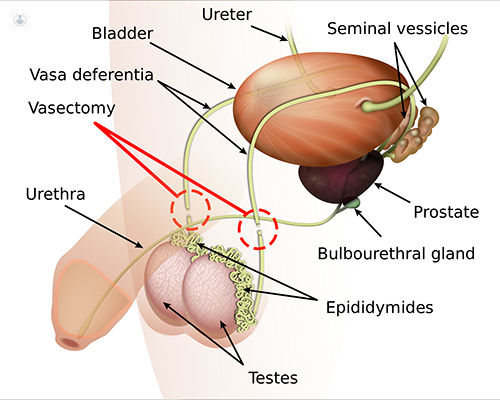



What is a vasectomy?
A vasectomy (also known as male sterilisation) is an operation to cut or seal the vas deferens (the tubes that carry sperm out of the testicles), as a form of permanent birth control. The sperm are unable to leave the testicles and therefore do not form part of the man’s ejaculate after the procedure, meaning that he cannot impregnate a female sexual partner.
Vasectomies are usually performed under local anaesthetic. They are over 99% effective as a contraceptive measure. Afterwards, the man is still able to have erections and ejaculate, and his sex drive shouldn’t be affected.
Why is it done?
A man may choose to have a vasectomy when he is certain that he doesn’t want to have any more children in the future. It is an important decision and it is highly recommended that he discuss it thoroughly with his partner before opting for a vasectomy. Vasectomy reversal, while possible, is not always successful, so the patient should be sure that he doesn’t want to father another child.
What does a vasectomy consist of?
A vasectomy is a simple outpatient surgical intervention. The doctor numbs the scrotum with local anaesthetic before operating.
There are two options, which will be discussed between patient and doctor and decided beforehand:
- Conventional vasectomy – the doctor makes two incisions in the skin of the scrotum, through which he can cut each tube and remove a small section, before either tying them or sealing them shut using heat. The incisions are then stitched up and left to heal.
- No-scalpel vasectomy – a minimally-invasive method, in which the doctor performs the operation through a tiny hole in the side of the scrotum, rather than an open incision. This causes less bleeding and is thought to lead to fewer complications than the conventional method, but requires a doctor with special training to perform.
Vasectomy does have certain risks – the testicles and scrotum are usually bruised and swollen, and some patients suffer ongoing pain. Blood can pool inside the testicles (haematoma) or hard lumps can form due to leaking sperm (sperm granulomas).
Preparation for vasectomy
Before opting for a vasectomy, the matter should be discussed with the patient’s doctor and partner, and in some cases, counselling may be recommended before the decision is made. It is important that the patient understands that there may not be any going back.
As with any surgery, it is important to follow the doctor’s instructions with regards to any medication the patient is taking.
On the day of surgery, it is important to wear loose and comfortable clothes, as well as to clean the scrotum area well.
Care after the intervention
The recovery is usually quick. Many men are able to return to work after a day or two, but it is important to avoid physical exertion or exercise during the first week. As after any other surgery, there is usually some discomfort after the operation.
With regards to sex, it is necessary to continue using contraception for the first 8-12 weeks after the operation to ensure that all remaining sperm have cleared the man’s tubes, but after this there should be no chance of pregnancy.